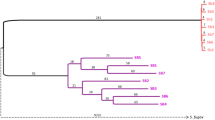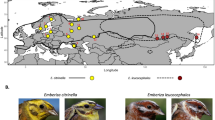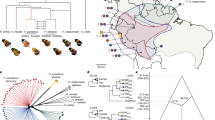Abstract
The evolutionary divergence of a single species into two has never beendirectly observed in nature, primarily because speciation can take a longtime to occur. A ring species, in which a chain of intergrading populationsencircles a barrier and the terminal forms coexist without interbreeding,provides a situation in which variation in space can be used to infer variationin time1,2,3. Here we reconstruct the pathway to speciationbetween two reproductively isolated forms of greenish warbler (Phylloscopustrochiloides). These two taxa do not interbreed in central Siberia butare connected by a long chain of intergrading populations encircling the TibetanPlateau to the south4. Molecular data and climatic history implythat the reproductively isolated taxa came into contact following expansionsnorthward around the western and eastern sides of the plateau. Parallel selectionpressures for increased song complexity during the northward expansions havebeen accompanied by divergence in song structure. Playback experiments showthat the two Siberian forms do not recognize each other's songs. Our resultsshow how gradual divergence in a trait involved in mate choice leads to theformation of new species.
This is a preview of subscription content, access via your institution
Access options
Subscribe to this journal
Receive 51 print issues and online access
$199.00 per year
only $3.90 per issue
Buy this article
- Purchase on Springer Link
- Instant access to full article PDF
Prices may be subject to local taxes which are calculated during checkout





Similar content being viewed by others
References
Mayr, E. Systematicsand the Origin of Species (Dover, New York, 1942).
Wake, D. B., Yanev, K. P. & Frelow, M. M. in Speciation and its Consequences (eds Otte,D. & Endler, J.) 134–157 (Sinauer, Sunderland,MA, 1989).
Wake, D. B. & Schneider, C. J. Taxonomy of the plethodontidsalamander genus Ensatina. Herpetologica 54, 279–298 (1998).
Ticehurst, C. B. A Systematic Review of the Genus Phylloscopus (Johnson Reprint, NewYork, 1938).
Martens, J. M. in Ecology and Evolution of Acoustic Communication in Birds (eds Kroodsma,D. E. & Miller, E. H.) 221–240 (Cornell Univ.Press, Ithaca, 1996).
Irwin, D. E., Alström, P., Olsson, U. & Benowitz-Fredericks, Z. M. Cryptic species in the genus Phylloscopus (Old World leaf warblers). Ibis (in the press).
Irwin, D. E. Song variation in an avian ring species. Evolution 54, 998–1010 (2000).
Frenzel, B. The Pleistocene vegetation of northern Eurasia. Science 161, 637–649 (1968).
Mayr, E. Populations,Species, and Evolution (Harvard Univ. Press, Cambridge, 1970).
Highton, R. Is Ensatina eschscholtzii a ring-species? Herpetologica 54, 254–278 (1998).
Wang, C.-W. The Forests of China (Maria Moors Cabot Foundation Publication No. 5,Botanical Museum, Harvard Univ., Cambridge, MA, 1961).
Menzies, N. K. Forest and Land Management in Imperial China (St. Martin’s, NewYork, 1994).
Marchetti, K. Dark habitats and bright birds illustrate the role of the environment in speciesdivergence. Nature 362, 149–152 (1993).
Marchetti, K. & Price, T. The adaptive significance of colourpatterns in the Old World leaf warblers, genus Phylloscopus. Oikos 79, 410–412 (1997).
Price, T. Morphology and ecology of breeding warblers along an altitudinal gradientin Kashmir, India. J. Anim. Ecol. 60, 643–664 (1991).
Orr, M. R. & Smith, T. B. Ecology and speciation. Trends Ecol. Evol. 13, 502–506(1998).
Rundle, H. D., Nagel, L., Boughman, J. W. & Schluter, D. Natural selection and parallel speciation in sympatric sticklebacks. Science 287, 306–308 (2000).
West-Eberhard, M. J. Sexual selection, social competition and speciation. Quart. Rev.Biol. 58, 155–183 (1983).
Bensch, S. & Härlid, A. Mitochondrial gene rearrangementsin songbirds. Mol. Biol. Evol. 17, 107–113 (2000).
Thompson, J. D., Higgins, D. G. & Gibson, T. J. CLUSTAL W: improving the sensitivity of progressivemultiple sequence alignment through sequence weighting, position specificgap penalites and weight matrix choice. Nucleic Acids Res. 22, 4673–4680 (1994).
Strimmer, K. & von Haeseler, A. Quartet-puzzling: a quartetmaximum-likelihood method for reconstructing tree topologies. Mol. Biol. Evol. 13, 964–969(1996).
Bensch, S., Price, T. & Kohn, J. Isolation and characterization of microsatellite loci in a Phylloscopus warbler. Mol. Ecol. 6, 91–92 (1997).
Acknowledgements
We thank J. Kohn for the use of his laboratory; P. Alström, K. Marchetti,U. Olsson, A. Richman, J. Tiainen, the British Museum and the Burke Museumfor samples; Z. Benowitz-Fredericks, J. Gibson, S. Gross, J. Irwin, G.Kelberg, A. Knorre, K. Marchetti and B. Sheldon for help in the field; A.Asbeck, M. Bouvier, H. Neville, K. Petren, R. Radtkey and A. Richmanfor technical assistance; T. Case, J. Coyne, M. Dantzker, D. Holway,J. Irwin, J. Kohn, T. Pärt, A. Qvarnström, A. Suarez, N. Tsutsui,M. Turelli, A. Uy and S. Vehrencamp for comments on the manuscript. Forfinancial support we thank the American Ornithologists’ Union, The ExplorersClub, the Jeanne Messier Memorial Fund, the National Geographic Society, theNational Science Foundation and Sigma Xi.
Author information
Authors and Affiliations
Rights and permissions
About this article
Cite this article
Irwin, D., Bensch, S. & Price, T. Speciation in a ring. Nature 409, 333–337 (2001). https://doi.org/10.1038/35053059
Received:
Accepted:
Issue Date:
DOI: https://doi.org/10.1038/35053059
This article is cited by
-
Evolutionary conservation and diversification of auditory neural circuits that process courtship songs in Drosophila
Scientific Reports (2023)
-
Evolution of communication signals and information during species radiation
Nature Communications (2020)
-
Testing the acoustic adaptation hypothesis with native and introduced birds in Hawaiian forests
Journal of Ornithology (2018)
-
Diploid versus haploid models of neutral speciation
Journal of Biological Physics (2016)
-
Behavioural response of the greater horseshoe bat to geographical variation in echolocation calls
Behavioral Ecology and Sociobiology (2016)
Comments
By submitting a comment you agree to abide by our Terms and Community Guidelines. If you find something abusive or that does not comply with our terms or guidelines please flag it as inappropriate.



